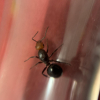- Formiculture.com
- Forums
- Gallery
- Members
- Member Map
- Chat

Never quite found out what kind of ant this is, but I'll do my best to describe and display.Location (on a map) of collection: Found in Missouri, USA.Date of collection: 9/15/17Habitat of collection: Near Dead Tree probably not matedLength (from head to gaster): 1-1.1cmColor, hue, pattern and texture: Black or Dark BrownDistinguishing characteristics: very smooth round gaster with maybe 1 visible node connecting, elbow shape antennaDistinguishing behavior: Can be aggressive when threatened, possibly stinging species by the way it curls gaster when provoked, loves sweet thingsNest description: Found same species located in a Dead TreeNuptial Flight: Not Sure collected date above
Formica Sp. maybe or a small Camponotus queen?
Colonies:
Founding:
Camponotus cf. Modoc
Camponotus cf. Herculeanus
Dream Ants:
Stenamma Diecki
Solenopsis Molesta
Manica Invidia
Camponotus Herculeanus
Lasius Latipes
Dorymyrmex Pyramicus
Tapinoma Sessile
I'm thinking the small Camponotus guess is correct based on photo comparison. The only Camponotus Queens I've been able to identify are twice the size of this one. I had about 6 alates of this species that are all the same size, most of which didn't make it through the winter. Is it normal to see Camponotus that are about 1cm or have they not fully developed?
I'm thinking the small Camponotus guess is correct based on photo comparison. The only Camponotus Queens I've been able to identify are twice the size of this one. I had about 6 alates of this species that are all the same size, most of which didn't make it through the winter. Is it normal to see Camponotus that are about 1cm or have they not fully developed?
i believe camponotus range any where from 1cm to almost 2cm with some of the large species, so it being normal yes probably. if it is a camponotus queen I'm leaning towards C. Pennsylvanicus or C. Neararticusbut i could be completely wrong with my ID as I'm new to identifying ants so hopefully someone whos a little better can come by and completely help you
Colonies:
Founding:
Camponotus cf. Modoc
Camponotus cf. Herculeanus
Dream Ants:
Stenamma Diecki
Solenopsis Molesta
Manica Invidia
Camponotus Herculeanus
Lasius Latipes
Dorymyrmex Pyramicus
Tapinoma Sessile
This is most likely C. nearcticus or C. caryae.
This is most likely C. nearcticus or C. caryae.
I notice a hint of red in the last picture. This is most likely C. nearcticus.
This is most likely C. nearcticus or C. caryae.
Agreed, it looks just like a C. caryae queen I once had.
I accidentally froze all my ants
My Main Journal | My Neivamyrmex Journal | My Ant Adoption | My YouTube
Join the TennesseeAnts Discord Server! https://discord.gg/JbKwPgs
i was so close ![]() lol
lol
Colonies:
Founding:
Camponotus cf. Modoc
Camponotus cf. Herculeanus
Dream Ants:
Stenamma Diecki
Solenopsis Molesta
Manica Invidia
Camponotus Herculeanus
Lasius Latipes
Dorymyrmex Pyramicus
Tapinoma Sessile
Definitely Camponotus! I'm not sure between caryae & nearcticus, but caryae seems probable (nearcticus has an elongated, sausage shaped gaster)
 |
Ant Keeping →
Ant Keeping Journals →
Formica ObscuripesStarted by Antguy , Nov 18 2024 |
|

|
|
 |
Ant Keeping →
Ant Keeping Journals →
Woodland Giants (Camponotus Ca-02)Started by AntsGodzilla , Nov 16 2024 |
|

|
|
 |
Ant Keeping →
Ant Keeping Journals →
Ender Ants Camponotus vicinus JournalStarted by Ender Ants , Nov 15 2024 |
|

|
|
 |
Ant Keeping →
Ant Keeping Journals →
Ender Ants Tetramorium immigrans JournalStarted by Ender Ants , Nov 12 2024 |
|

|
|
 |
Ant Keeping →
Ant Keeping Journals →
Ender Ants Camponotus modoc JournalStarted by Ender Ants , Nov 12 2024 |
|

|
0 members, 1 guests, 0 anonymous users